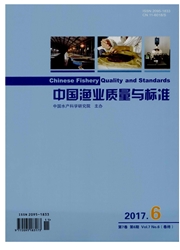

 中文摘要:
中文摘要:
中国作为水产养殖大国,对饲料的需求量巨大,但化学性的饲料防霉剂仍存在一定的隐患.当今可食海藻资源丰富,本研究拟开发新型可食海藻防霉剂并探明其对产毒镰孢菌的控制效应.采用拮抗培养法,通过测定菌落弧长以及菌的生长抑制率,考察培养基中加入可食海藻防霉剂后,其抑菌浓度和抑菌圈弧长的关系.采用Box-Behnken 试验考察海带添加量、碘添加量、pH因素对抑菌效应的影响.研究表明海藻防霉剂抑菌浓度和抑菌圈弧长呈负相关,其中海带加碘化钾防霉剂(K+I)作用效果明显优于其他可食海藻防霉剂.而且海带添加量对防霉剂的抑菌效应影响明显,因此可食海藻防霉剂的配方为海带粉∶碘化钾=4∶1(m/m)(pH=7).其对5种产毒镰孢菌(IBE2、IBE8、JX-6、J189-6-1和JX-9)的生长抑制率分别为63.95%、70.00%、58.00%、60.00%和69.44%,对产毒镰孢菌IBE2的抑菌效应显著,其最小抑菌浓度(MIC)为137.67 mg/mL.本研究为农业生产各领域提供了更安全有效的可食海藻防霉剂的配方参考,能有效地解决凡纳滨对虾养殖饲料中镰孢菌污染问题,有助于对虾的商业化养殖.
 英文摘要:
英文摘要:
China, as a major aquaculture country, has huge demand for feed in aquaculture, but there still exists certain hidden danger of chemical mildew preventive. Now there are rich edible seaweed resources. The study was in- tended to develop novel edible seaweed mildew preventive and prove its inhibition on toxin - producing Fusarium spp. By adopting the antimicrobial substance culture method, and measuring its bacterial colony arc length and growth inhibition ratio, we investigated the relationship between inhibitory concentration and arc length of inhibition zone when medium was added to the edible seaweed mildew preventive. The inhibition effect of kelp content, iodine content and pH was measured by Box - Behnken test. Results showed the negative correlation between inhibitory concentration and arc length of inhibition zone and the mildew preventive with kelp and iodine ( K + I) was more effective than others. And kelp content was more effective in inhibition. Then the inhibition ratio on the five different Fusarium ( IBE2, IBE8, JX - 6 JX189 - 6 - 1 and JX - 9) were 63.95% , 70.00% , 58.00%, 60.00% and 69.44%, which IBE2 was the most active, that IBE2 was inhibited remarkably than other Fusarium, and its MIC was 137.67 mg/mL. The study provided reference for a safer and more effective edible seaweed mildew preventive for the various fields in agriculture, thus solving the Fusarium spp. pollution of feeding Litopenaeusvannamei effectively. It will contribute to the aquaculture of Litopenaeusvannamei. [ Chinese Fishery Quality and Standards, 2015, 5 (3):54- 62 ]
 同期刊论文项目
同期刊论文项目
 同项目期刊论文
同项目期刊论文
 期刊信息
期刊信息
